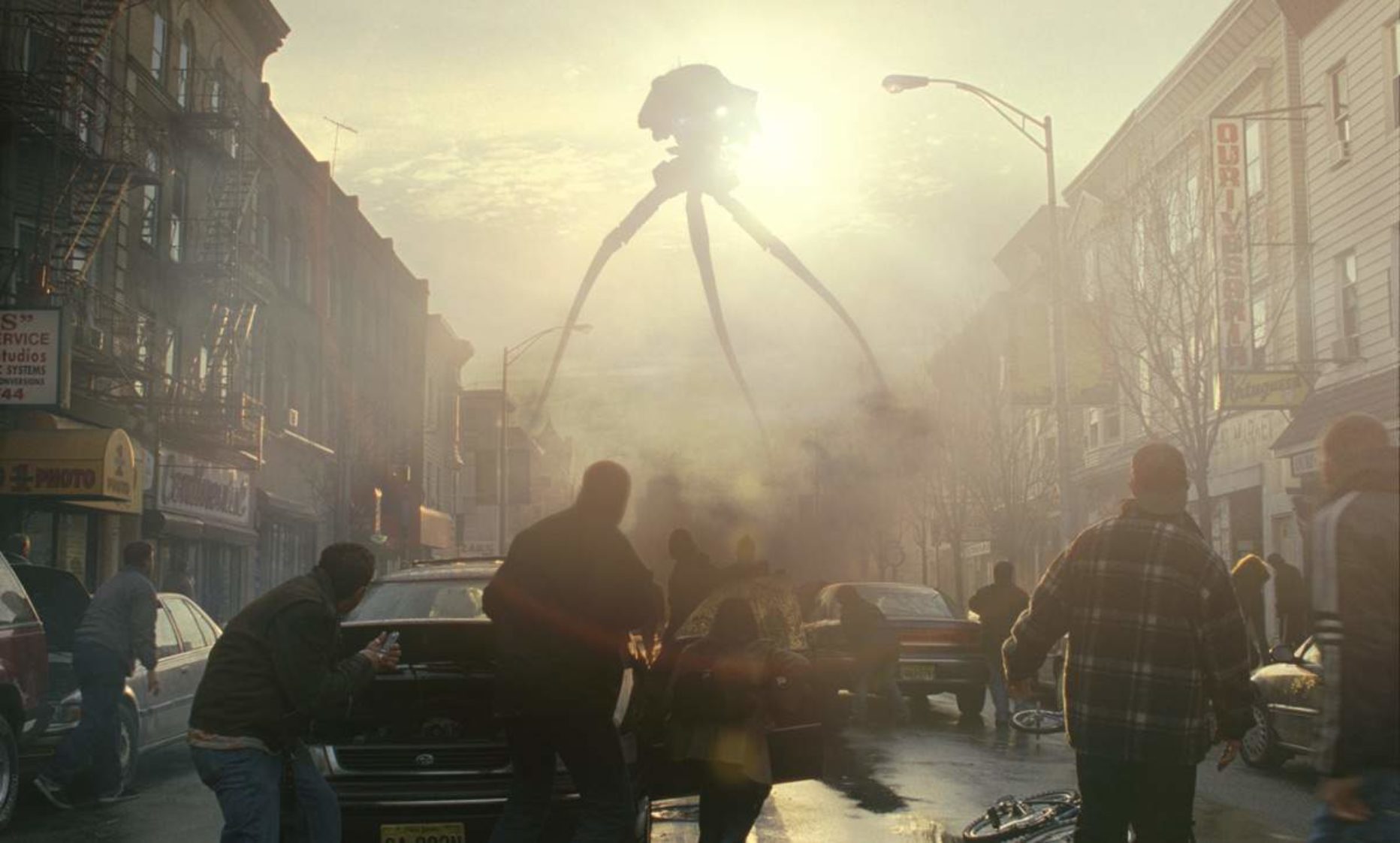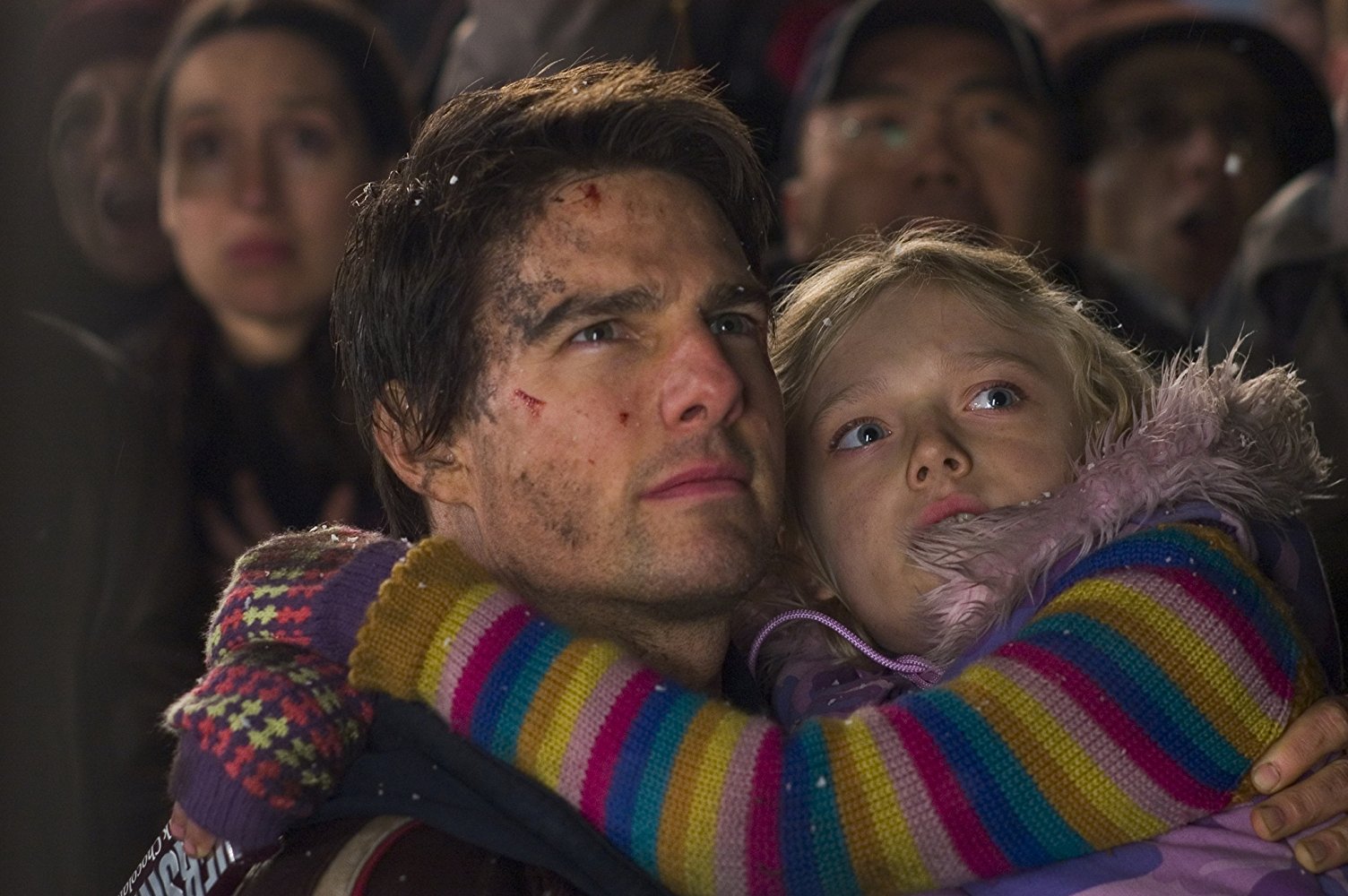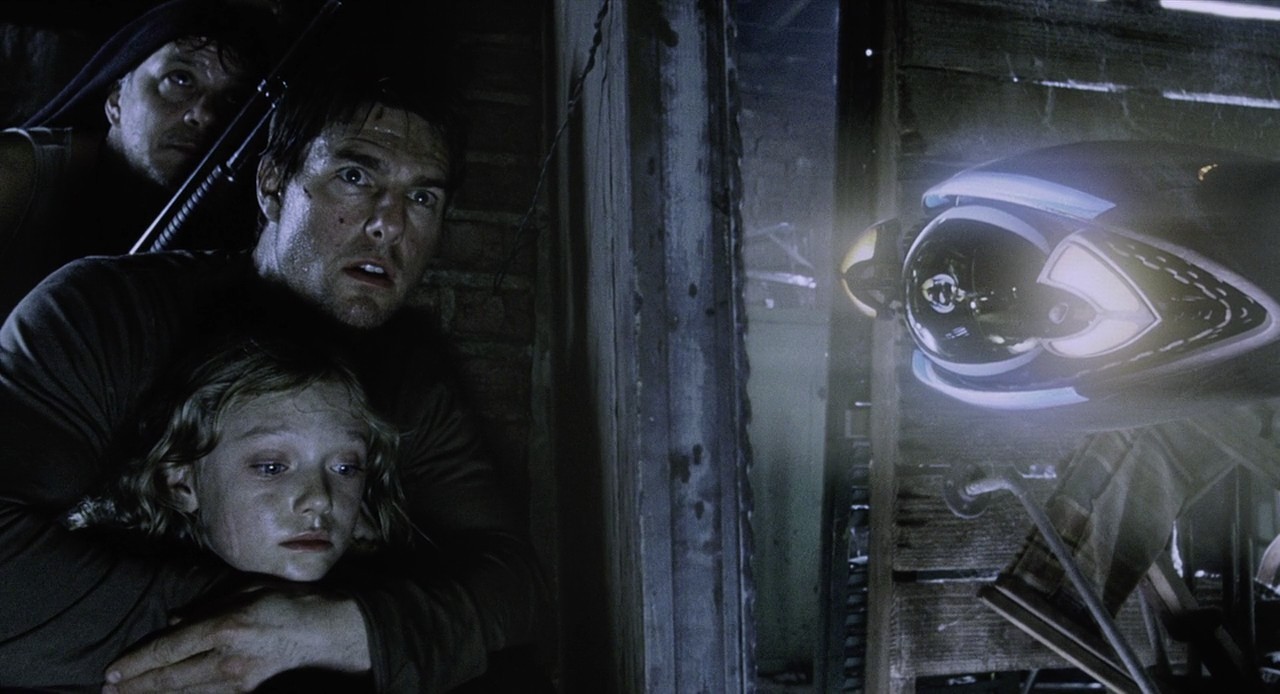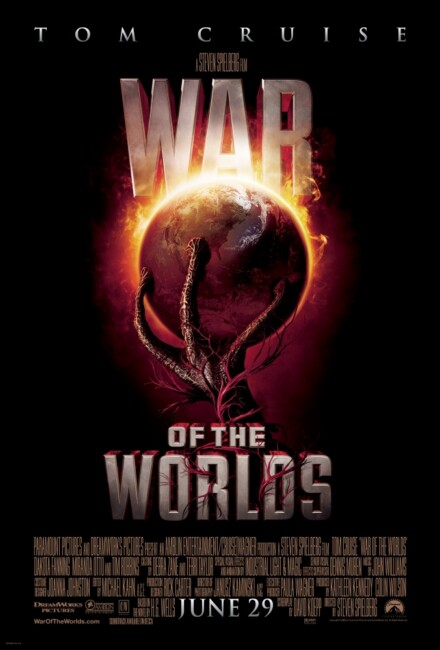USA. 2005.
Crew
Director – Steven Spielberg, Screenplay – Josh Friedman & David Koepp, Based on the Novel The War of the Worlds (1898) by H.G. Wells, Producers – Kathleen Kennedy & Colin Wilson, Photography – Janusz Kaminski, Music – John Williams, Senior Visual Effects Supervisor – Dennis Muren, Visual Effects Supervisor – Pablo Helman, Visual Effects – Industrial Light and Magic (Animation Supervisor – Randy M. Dutra), Special Effects Supervisor – Daniel Sudick, Creature Effects – Stan Winston Studio (Supervisors – Lindsay McGowan), Production Design – Rick Carter. Production Company – Paramount/DreamWorks SKG/Amblin Entertainment/C-W Productions.
Cast
Tom Cruise (Ray Ferrier), Dakota Fanning (Rachel Ferrier), Justin Chatwin (Robbie Ferrier), Tim Robbins (Harlan Ogilvy), Miranda Otto (Mary Ann)
Plot
New Jersey stevedore Ray Ferrier is left with custody of his two children – his teenage son Robbie and younger daughter Rachel – while his ex-wife goes to Boston for the weekend. At the same time, there are reports of lightning storms all over the world. One of these hits the town centre and Ray is witness as a giant machine on tripod legs emerges from the ground and starts blasting people with a heat ray, smashing everything in its path. Ray takes a car and flees with the two children. As they try to seek shelter, the alien machines create mass destruction across the countryside and humanity seems powerless against them.
H.G. Wells’s novel The War of the Worlds (1898) is one of the classic works of science fiction. This is due to one very small reason – it was the first ever alien invasion story. The book has reportedly never been out of print ever since it first appeared over a century ago. The story has had enormous influence and has been adapted into just about every medium. Orson Welles made the famous 1938 radio version, which attained much notoriety when Welles’s simulation of a news broadcast led people to think the real thing was happening, creating a public panic. (The tv movie The Night That Panicked America (1975) is a dramatisation of these events). Elsewhere, there have been numerous audio adaptations of the story, in particular Jeff Wayne’s best-selling musical LP War of the Worlds (1977). There have been a number of comic-book and graphic novel adaptations, most notably Marvel Comics’ Killraven (1973-6), which lasted for 39 issues and was set in the aftermath of the invasion but diverged from H.G. Wells considerably, while DC had Superman battling the Martian war machines at one point. There have been all manner of book sequelia – the mediocre The Second War of the Worlds (1976) by George H. Smith and pastiches like Sherlock Holmes’s The War of the Worlds (1975) by Wade and Manley Wade Wellman and the highly amusing War of the Worlds: Global Dispatches (1996), a collection by various modern authors that purports to give views of the invasion as written by historical/literary figures of the era; as well as references in Christopher Priest’s The Space Machine (1975), the League of Extraordinary Gentleman comic strip and homages like John Christopher’s Tripods books.
The most famous of the adaptations was the film version The War of the Worlds (1953) from producer George Pal, which is a genre classic. In the same way that H.G. Wells’s novel pioneered the alien invasion story, the George Pal film created the alien invader genre of the 1950s. It surprises some people to learn that War of the Worlds has never been remade up until now. The Pal film was spun off as a tv series sequel War of the Worlds (1988-90) but this widely varied from both the book and film. There was also the Polish film The War of the Worlds – Next Century (1981), although this has nothing to do with H.G. Wells and concerns authoritarian media censorship. Come 2005 and there was suddenly no less than three adaptations of the novel – one being released only one month before this with Pendragon Pictures’ independently made The War of the Worlds (2005). The Pendragon version retains the Victorian setting and follows the novel very closely. This was followed two weeks later by War of the Worlds (2005), a low-budget modernised version from The Asylum starring C. Thomas Howell, which later spawned a sequel War of the Worlds 2: The Next Wave (2008). The late 2010s saw a further resurgence of interest with The War of the Worlds (2019), a three-part BBC tv mini-series set during the Victorian period; War of the Worlds (2019- ), a tv series that relocates action to the contemporary European Union; The Asylum’s modernised Alien Conquest (2021); and the contemporary Young Adult film War of the Worlds: The Attack (2023)
Further afield there was also Jeff Wayne’s Musical Version of The War of the Worlds (2006), a dvd-released version of a stage performance of the best-selling 1977 musical album, the interesting War of the Worlds: Goliath (2012), an animated film set in an alternate history 1914 with Steampunk mecha taking on the second Martian invasion; and The Great Martian War: 1913-1917 (2013), a mockumentary retelling that blends CGI tripod war machines with WWI film footage, while Marvel Entertainment announced a plan to make a film out of Killraven that has yet to emerge. The same period also saw an upsurge of publishing interest with the likes of Douglas Niles’s War of the Worlds: New Millennium (2005), a modernised reworking of the Wells story, and Kevin J. Anderson’s The Martian War: A Thrilling Eyewitness Account of the Recent Invasion as Reported by Mr H.G. Wells (2006), which winds in a host of other Wells characters and historical personages.

This version of The War of the Worlds comes from Steven Spielberg, who needs no introduction as the most successful director in the world. (See the bottom of the page for Steven Spielberg’s other genre films). Spielberg had been interested in remaking The War of the Worlds for some time – he was said to have been toying with the idea in the mid-1990s, only to be beaten to it by Independence Day (1996). Spielberg has teamed forces with Tom Cruise, who previously starred in Spielberg’s Minority Report (2002). Tom Cruise was also reported to have been interested in the War of the Worlds property and was said to be prepping his own version in 2001, only to have been forced to put it on hold when 9/11 came along and took the idea of mass destruction out of the realms of entertainment and into the grimly real. Though the film often varies widely from the H.G. Wells book – most notedly in updating the setting to contemporary America (as both Orson Welles and George Pal did) – it is faithful to the novel, certainly more so than Pal ever was. The film follows most of the basic elements from the story – there is the Red Weed; an equivalent of the scenes where the hero’s brother sees the crowds fleeing en masse and witnesses the Martian attack on the warship Thunder Child (turned into a ferry here); as well as the images of the Martians capturing humans in baskets beneath their machines.
Tim Robbins turns up as the equivalent of the book’s character of the curate (actually he is a combination of three characters from the book – the cowardly and crazed curate, whom the narrator is forced to hide with in a cellar after a Martian war machine lands above; the artilleryman who makes elaborate but ineffectual plans for humanity relocating underground; while he is also given the name of Ogilvy, the astronomer that the narrator visits in the opening scenes). What I was interested to see was whether the film would retain the scene in the book where the hero kills the curate to stop him from giving them away to the Martians or whether such a scene would be deemed too nasty for Steven Spielberg’s family audience. Thankfully, Spielberg and screenwriters do not wimp out on this – indeed, in the Wells story, the narrator’s blow was only intended to silence the curate and accidentally ended up killing him, whereas Tom Cruise’s beating of Tim Robbins seems very much intentional. On the other hand, this version noticeably removes all religion from the equation – in the book, the curate who was reduced to cowardice and meaningless babble represented H.G. Wells’s contempt for religion, while the 1953 film went completely the opposite direction and embraced religion to show the Almighty acting on humanity’s side and people on a hillside giving up thanks for their delivery afterwards. By contrast to these two extremes, Spielberg’s film is noticeable for its lack of engagement on any matters of religion.
The film’s most noticeable change is to have the invading aliens no longer be Martians. In fact, there is no reference to Martians or Mars anywhere throughout the film. One is not sure whether this has something to do with making a credible nod towards modern science – the recognition that Mars would not be able to support any kind of life – or what. In its place, the film substitutes an unconvincing piece about the invaders coming from underground but this is ill-explained and not expanded upon beyond the single scene in the tv van. In its place the film substitutes an unconvincing piece about the invaders coming from underground where they have been hiding for millions of years (apparently entirely undetected by geologists or miners) but this is ill-explained and not expanded upon. War of the Worlds also welcomely uses a full arsenal of Industrial Light and Magic effects to give the tripedial war machines life, rather than take the shortcut that George Pal did of shearing their legs off and making them into flying machines.
There are some scenes from the book that one cannot help but think would have worked well in the film – like where the deputation approaches the impact site holding a white flag, only to be crisped. One would also have thought the scene from the 1953 film where the US military attempted to use the A-bomb against the Martians to no effect would have worked well here; instead we get some far less exciting scenes with the invaders disintegrating Humvees and tanks. (In a trivia note, one can see that the film uses elements from all major versions of the story – the aforementioned sections from H.G. Wells; the scenes in the cellar and the climax where the dying Martian falls out in front of a crowd taken from the Pal version; while also transferring action to New Jersey in homage to Orson Welles. There is a nice touch when Tom Cruise does finally reunite with his family and we see that Gene Barry and Ann Robinson, the two leads from the 1953 film, play his maternal in-laws. I kept wondering if they would find a way to reference the Jeff Wayne musical version but apparently not).

The one element that Steven Spielberg adds to H.G. Wells is the addition of a child. This is not too surprising considering that War of the Worlds is a Steven Spielberg film. In H.G. Wells’ novel, we knew so little about the narrator that he was never even given a name. The 1953 film added a flat romance at the centre of proceedings and the ultimate message the film had when the Martian war machines came crashing down was that it showed that God was on humanity’s side. Here the invasion of Earth seems to serve as a psychodramatic backdrop against which one man can reconnect with his family and shoulder his responsibilities as a parent – growing up, Spielberg had an absent father and in just about every one of his films, there is the recurrent theme of someone who undergoes a journey to eventually bring them back into the all-accepting arms of a family. One welcome touch about War of the Worlds is Spielberg’s placing the family in working class surroundings. In films like E.T.– The Extra-Terrestrial (1982) and Poltergeist (1982), Spielberg was criticised of putting his middle-class families in expensive homes that would be well beyond their income bracket so it is appealing here to see Tom Cruise playing a blue collar worker who lives in a shabby two-bedroom rental in a working class neighbourhood (even if it is hard to swallow the sight of the highest paid actor in the world slumming it as an ordinary working stiff).
Though Steven Spielberg is primarily associated with heart-warming children’s films, he can be a director of many faces. There is the Spielberg who can create relentless suspense – Duel (1971) and Jaws (1975); the Spielberg who has a strong liberal historical conscience – The Color Purple (1985), Schindler’s List (1993), Amistad (1997) and Munich (2005); the Spielberg who makes mature and thoughtful science-fiction – A.I. (Artificial Intelligence) (2001) and Minority Report; even the Spielberg who secretly enjoys the life of the rogue who can pull a fast one over authorities that we see in Catch Me If You Can (2002). War of the Worlds is fairly much the Steven Spielberg who likes to delight and awe audiences with special effects, the Spielberg that we saw in Close Encounters of the Third Kind (1977) and Jurassic Park (1993) – indeed, Jurassic Park is the film that largely created the modern CGI spectacle blockbuster.
War of the Worlds is very much a special effects blockbuster. For all that the film toplines Tom Cruise – indeed, for all the fact that promotion of the film seemed overshadowed by bizarre tabloid headlines about Tom Cruise (his romance with Katie Holmes, his couch-jumpings pronouncements of love on Oprah, pranksters arrested for squirting water in his face, his preaching of Scientology and denouncements of psychiatry on various chatshows) – Cruise is almost irrelevant to War of the Worlds. Almost any actor could have filled the role that Cruise plays. Although, the one thing that the film did get out of Tom Cruise is a star name to draw audiences is. Though the effects are the star of the show, very little was shown of them in the advance trailers – just some shots of bridges being swept away – and nothing at all of the war machines or the aliens. Steven Spielberg did the same with Jurassic Park, building us up to but showing little of the dinosaurs until we sat down to watch the film.
The film starts slowly. Audiences chatter through the establishing scenes but abruptly fall to silence when the war machines appear. Steven Spielberg creates a dazzling scene where we first see the war machine as its leg comes slamming down beside Tom Cruise whereupon Spielberg’s camera pans up and keeps going until we see its full enormity towering overhead, before it starts blasting and incinerating people, toppling the surrounding buildings and tossing cars aside. Spielberg loves these moments – there was a similar occasion when he first unveiled the dinosaurs to us in Jurassic Park – and the scene holds a breathless awe. Spielberg throws up other amazing set-pieces with the attack on the ferry; the scenes where Dakota Fanning is captured and Tom Cruise is swept up into the basket of a war machine; and strikingly surreal visions like that of a burning train passing through a railway crossing. The main disappointment is that the spectacle is the sum of the film. There is not much to War of the Worlds beyond it being a special effects vehicle. As such, it does so adequately – it provides dazzle and wow, mass destruction, suspense and tension – which is all that one asked of the film. In the scheme of things though, War of the Worlds is probably not going to do down as one of the great Steven Spielberg films – it certainly sits above 1941 (1979), Hook (1991), The Lost World: Jurassic Park (1997) and the Indiana Jones sequels, although not quite up there with the greatly underrated Spielberg films like The Sugarland Express (1974), Empire of the Sun (1987), A.I. and Munich.

All the previous versions of War of the Worlds have in some way been works of their times that presaged contemporary social uncertainty. The H.G. Wells novel has been read as a warning about the hubris of the British Empire where Wells abruptly inverted colonialism and had the Martians treat humanity the same way that the British did when they conquered Africa and the Indian subcontinent. The Orson Welles radio adaptation sat on the cusp between the end of the Great Depression and the arrival of the Second World War where the world was in a state of uncertain tension economically and politically. The 1953 film came out just after World War II when the world was reeling in fear at the unleashing of the atomic bomb and the perceived threat of Communism and, as in the climax of the film, the American nation was trying to rally around a sense of unity and belief in the Almighty as a way of regaining certainty in the face of these threats.
War of the Worlds 2005 unquestionably becomes a version of the story that sits atop the enormous uncertainty and divisiveness of America post 9/11. It is impossible not to view the film and see reflections of 9/11 in the images of people fleeing in panic as buildings come crashing down, in the walls of photographs of the missing, in the people mindlessly wishing to join the fight back against the invader to get the sense of outrage out of their system. Young Dakota Fanning’s immediate assumption as the attack happens is to ask “Is it the terrorists?” War of the Worlds also comes at a time after the initial worldwide outrage at what happened on 9/11 was manipulated by the Bush administration into the hugely unliked Iraq War – a war where the USA seemed deeply split for and against and the rest of the world utterly opposed. In this sense, it is perhaps worth comparing War of the Worlds to Independence Day. Independence Day came pre-9/11 and is fired up with a gung ho flag-waving patriotism where the President personally leads the fight back against the enemy with triumphal results. Independence Day seems to anticipate the Iraq War in its red-blooded patriotic sentiments; on the other hand, War of the Worlds comes after that war has been fought in the real world and is an altogether grimmer affair. Here there is no red-blooded patriotism, just the sense of one man trying to save his family. Rather than celebrating the rush to fight back, here we have a scene where Tom Cruise is screaming his lungs out trying to get his son not to mindlessly run off into the midst of combat. When the climax of War of the Worlds comes, there is no heroic triumph, just the weary relief that the onslaught has finally ended. Much like it is in the real world at the end of a war when the fired-up patriotism has died away and people are left stunned wondering what has happened and are faced with confronting the sobering realities that loved ones are not coming back.
War of the Worlds was parodied in Scary Movie 4 (2006).
Steven Spielberg’s other films of genre interest are:– Duel (1971), LA 2017 (1971), Something Evil (tv movie, 1972), Jaws (1975), Close Encounters of the Third Kind (1977), Raiders of the Lost Ark (1981), E.T. – The Extra-Terrestrial (1982), Twilight Zone – The Movie (1983), Indiana Jones and the Temple of Doom (1984), Indiana Jones and the Last Crusade (1989), Always (1989), Hook (1991), Jurassic Park (1993), The Lost World: Jurassic Park (1997), A.I. (Artificial Intelligence) (2001), Minority Report (2002), Indiana Jones and the Kingdom of the Crystal Skull (2008), The Adventures of Tintin (2011), The BFG (2016) and Ready Player One (2018). Spielberg has also acted as executive producer on numerous films – too many to list here. Spielberg (2017) is a documentary about Spielberg.
(Nominee for Best Special Effects at this site’s Best of 2005 Awards).
Trailer here


